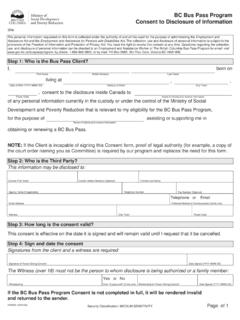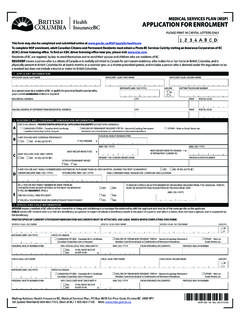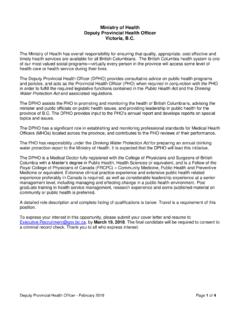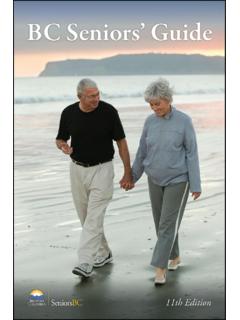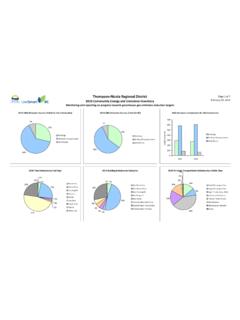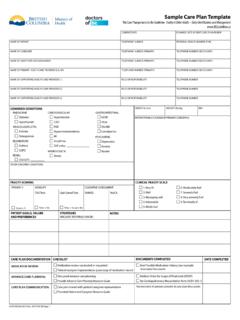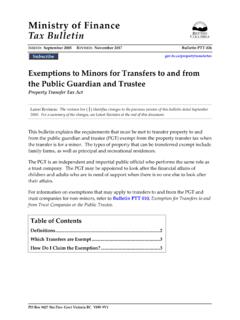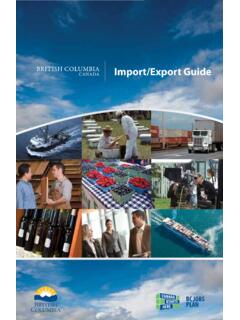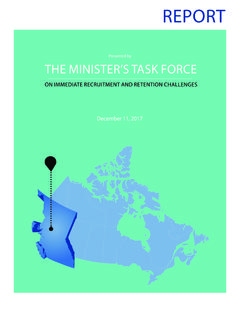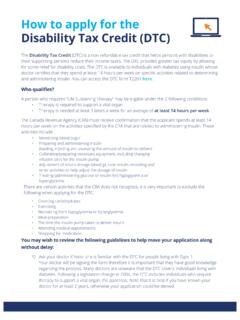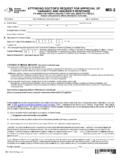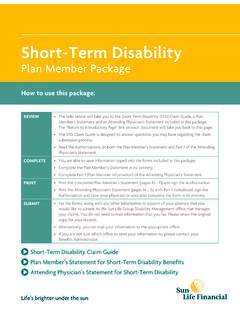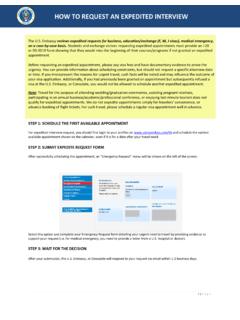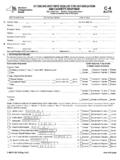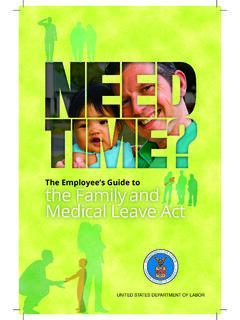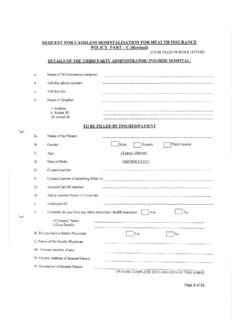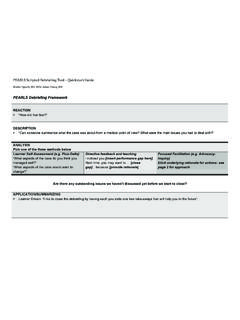Transcription of Emergency Medical Assistants Licensing ... - British Columbia
1 Page 1 of 10 Emergency Medical Assistants Licensing Board EMALB 2017-01 Continuing Competence Requirements Responsible Branch: Emergency Medical Assistants (EMA) Licensing Branch Contact: Continuing Competence Program Administrator Reference Information (Manual, page number, chapter): Replaces former policy: Continuing Competence Requirements EMALB 2016-14 Date Effective: April 1, 2017 Last Update: May 5, 2021 Next Review Date: January 2021 Keywords continuing competence, regulation 1. Policy Rationale & Purpose: The purpose of this policy is to describe the continuing competence reporting requirements and processes for Emergency Medical Assistants (EMAs) in British Columbia (BC) at the Emergency Medical Responder (EMR) licence category and higher. The continuing competence reporting requirements for EMAs are outlined in Part 4 of the Emergency Medical Assistants Regulation BC Reg 210/2010 (the Regulation).
2 In each reporting period, EMAs are required to complete and submit to the Director s satisfaction, 20 patient contacts and 20 continuing education credits using the system developed for the purpose (EMACCS). These requirements ensure ongoing safe, ethical, and competent practice by EMAs. The requirements are intended to ensure that EMAs maintain and improve their knowledge and practice through continuing education and patient contacts. EMAs must participate in continuing education activities that are relevant to the EMA s licence category. The Continuing Competence Reporting Policy is divided into the following areas: Reporting Requirements Continuing Education Credits and Patient Contacts Continuing Education Activities Patient Contacts Timelines Submission Reviews Definitions Page 2 of 10 2.
3 Policy Scope The continuing competence reporting requirements apply to all EMAs at the EMR licence category and higher. The requirements apply regardless of the EMA s employer, status ( Medical leave or maternity/parental leave), employment status, or residence inside or outside BC. The continuing competence reporting requirements do not apply for the period during which an EMA held a student licence. In addition, if an EMA s initial licence was issued not more than one year prior to March 31st an EMA is not required to meet the continuing competence requirements in section 17 to 20 of the Regulation for the year in which the licence was issued. For example, if your licence was issued on March 1st, 2019, you would be required to submit your continuing competence requirements as of April 1, 2019.
4 You are only exempt from the reporting period in which your licence was issued. 3. Policy Statement: Reporting Requirements for Continuing Education Credits and Patient Contacts For each reporting period, EMAs are required to submit 20 patient contacts and 20 continuing education credits. Patient contacts and continuing education credits must be entered by the EMA into the web-based Emergency Medical Assistants Continuing Competence System (EMACCS). In a reporting period, if an EMA accumulates fewer than 20 patient contacts and more than 20 continuing education credits, the EMA may substitute the excess continuing education credits, on a one-to-one basis, for the patient contacts. You cannot substitute patient contacts for continuing education credits. An EMA who fails to meet the continuing competence requirements, as per the Regulation, will be notified by the Director via registered mail.
5 An EMA who receives a notice may request an adjudication, where the EMA must set out the reasons the EMA believes they have met the continuing competency requirements by notifying the Director and supplying additional documentation. After reviewing the additional documentation, if the Director continues to believe the EMA failed to meet the reporting requirements, the Director may require the EMA to complete written or practical examinations. An EMA who does not comply with the continuing competency provisions in the Regulation may be subject to disciplinary action under Section 7(1)(b) of the Emergency Health Services Act; for example, if the EMA does not request adjudication, or does not successfully complete the required written or practical examinations after adjudication, the EMA may be referred to the Licensing Board for disciplinary action.
6 Page 3 of 10 Continuing Education Activities The Regulation defines continuing education activity to mean a training or educational program, course, seminar or similar activity . The Director maintains a list of continuing educational activities that have been pre-approved for continuing education credits (the pre-approved activity list ). If a continuing education activity is not on the pre-approved activity list, an EMA may request that the Director approve the continuing education activity so that the EMA may receive continuing education credits for it. If a continuing education activity that is available on the pre-approved activity list is submitted using the Submit Other Activities page, the activity will be given zero credits and the EMA will be instructed to use the Submit Approved Activities page to submit the activity.
7 In considering whether to grant continuing education credits in respect of a continuing education activity, the Director must be satisfied that the activity is relevant to the knowledge, skill or abilities required of an EMA in the course of practicing the profession. Continuing educational activities submitted by the EMA must directly relate to: a service described in Schedule 1 of the Regulation, or endorsement described in Schedule 2 which may be performed by an EMA registered in the licence category held by the EMA requesting the credit a matter included within the EMA Code of Ethics set out in Schedule 3 of the Regulation one or more, General Competencies , set out in the National Occupancy Competency Profile for Paramedics (NOCP), published by the Paramedic Association of Canada, dated October 2011, for the level of paramedic described in the NOCP which most closely aligns with the licence category of the EMA requesting the credit.
8 Credits will be assigned based on the length of the activity, how the activity relates to the NOCPs, and the services/endorsements the EMA may provide and/or how the activity relates to the EMA Code of Ethics. Credits will not be allocated for activities that do not relate to pre-hospital care. When determining how many credits to allocate to an educational activity for which credits are requested, the Director may allocate up to one credit per hour for educational activities that relate to pre-hospital patient care. For example, activities that would fall within the NOCP topic Areas 4 (Assessment and Diagnosis), 5 (Therapeutics) and 6 (Integration), would qualify as patient care. Educational activities which cover subject areas described within these topic areas, would generally qualify as one credit per hour of education completed (see below table).
9 By contrast, the Director may allocate up to credits for educational activities undertaken in areas that do not relate to direct patient care, despite the duration of the educational activity. For example activities that are one day or less in length and that fall within the NOCP topic Areas 1 (Professional Responsibilities), 2 (Communication), 3 (Health and Safety), 7 (Transportation), or 8 (Health Promotion and Public Safety), will qualify for credits, however; activities greater than one day will be reviewed on a case by case basis and the Director may allocate credits per day to a maximum of 5 credits regardless of duration (see table below). One day is considered a minimum of seven hours of educational training. Page 4 of 10 Assignment of Continuing Education Credits NOCP Topic Area # of credits per activity NOCP 1 Professional Responsibilities 1 day credits or > 1 day on a case by case basis NOCP 2 Communication 1 day credits or > 1 day on a case by case basis NOCP 3 Health and Safety 1 day credits or > 1 day on a case by case basis NOCP 4 Assessment and Diagnostics 1 per hour NOCP 5 Therapeutics 1 per hour NOCP 6 Integration 1 per hour NOCP 7 Transportation 1 day credits or > 1 day on a case by case basis NOCP 8 Health Promotion and Public Safety 1 day credits or > 1 day on a case by case basis In order for a continuing education activity to be considered for continuing education credits, the activity, when delivered to the EMA.
10 Must be comprised of at least one-half hour of instructional activity and the EMA must be able to provide a certificate of completion or verification of attendance. When reporting continuing education credits for a continuing education activity, the EMA must be able to verify that: the EMA participated in the activity for the purpose of obtaining education and not for the purpose of acting as examiner or evaluator; and the EMA successfully completed the continuing education activity by attending the full duration of the activity and any evaluations. Acceptable continuing education activities: Treatment and Management of Ischemic Stroke safeTALK Provincial Opioid Addiction Treatment Support Program Curriculum Development Clinical Rounds that are attended in person and can be signed off by the doctor Unacceptable continuing education activities: Fit testing Emergency Preparedness: Personal and Family BCEHS Hand Hygiene Safety Inspections PARTY Program Evaluations or exams Eyelash Technician Course Birthing or raising a child Webinars of any kind Clinical Rounds that are not attended in person Page 5 of 10 Verification of Activities Supporting documentation for courses and educational activities completed must be kept for a minimum of three years.
